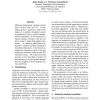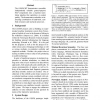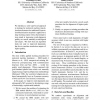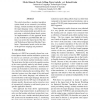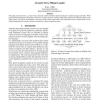ACL
2006
14 years 3 months ago
2006
Obtaining high-quality machine translations is still a long way off. A postediting phase is required to improve the output of a machine translation system. An alternative is the s...
ACL
2006
14 years 3 months ago
2006
When training the parameters for a natural language system, one would prefer to minimize 1-best loss (error) on an evaluation set. Since the error surface for many natural languag...
ACL
2006
14 years 3 months ago
2006
Thesauri and ontologies provide important value in facilitating access to digital archives by representing underlying principles of organization. Translation of such resources int...
ACL
2006
14 years 3 months ago
2006
The LOGON MT demonstrator assembles independently valuable general-purpose NLP components into a machine translation pipeline that capitalizes on output quality. The demonstrator ...
ACL
2006
14 years 3 months ago
2006
We introduce a semi-supervised approach to training for statistical machine translation that alternates the traditional Expectation Maximization step that is applied on a large tr...
ACL
2006
14 years 3 months ago
2006
In this paper, we argue that n-gram language models are not sufficient to address word reordering required for Machine Translation. We propose a new distortion model that can be u...
NAACL
2007
14 years 3 months ago
2007
This article describes a machine translation system based on an automatic post-editing strategy: initially translate the input text into the target-language using a rule-based MT ...
NAACL
2007
14 years 3 months ago
2007
The quality of a sentence translated by a machine translation (MT) system is difficult to evaluate. We propose a method for automatically evaluating the quality of each translati...
NAACL
2007
14 years 3 months ago
2007
This paper presents a maximum entropy machine translation system using a minimal set of translation blocks (phrase-pairs). While recent phrase-based statistical machine translatio...
LREC
2008
14 years 3 months ago
2008
This paper presents MISTRAL, an open source statistical machine translation decoder dedicated to spoken language translation. While typical machine translation systems take a writ...
